
Farrukhsiyar or Farrukh Siyar was the tenth emperor of the Mughal Empire from 1713 to 1719. He rose to the throne after assassinating his uncle, Emperor Jahandar Shah. Reportedly a handsome man who was easily swayed by his advisers, he lacked the ability, knowledge and character to rule independently. He was an emperor only in name, with all effective power in the hands of the Sayyids of Barah. Farrukhsiyar was the son of Azim-ush-Shan and Sahiba Niswan.
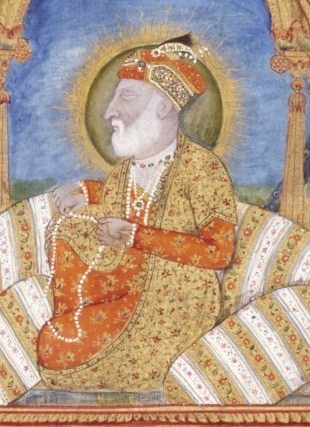
Shah Alam II, also known by his birth name Ali Gohar, was the seventeenth Mughal Emperor and the son of Alamgir II. Shah Alam II became the emperor of a crumbling Mughal Empire. His power was so depleted during his reign that it led to a saying in the Persian language, Sultanat-e-Shah Alam, Az Dilli ta Palam, meaning, 'The empire of Shah Alam is from Delhi to Palam', Palam being a suburb of Delhi.
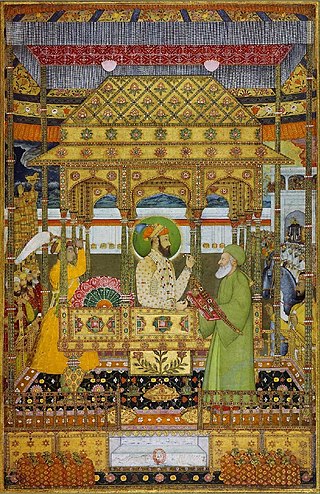
Mirza Azim-ush-Shan was the second son of Mughal emperor Shah Alam I, by his second wife, Amrita Bai, Princess of Kishangarh. He was the grandson of Emperor Aurangzeb, during whose reign, he was the subahdar (viceroy) of Bengal Subah, Bihar and Odisha from 1697 to his death in 1712, and the great grandson of Emperor Shah Jahan.

Mir Syed Jafar Ali Khan Bahadur was a commander-in-chief or military general who reigned as the first dependent Nawab of Bengal of the British East India Company. His reign has been considered by many historians as the start of the expansion of British control of the Indian subcontinent in Indian history and a key step in the eventual British domination of vast areas of pre-partition India.

Mirza RajaMan Singh I was a Kachhwaha-Mughal general and minister who served as the 24th Raja of Amber from 1589 to 1614 and the Subahdar of Bengal for three terms from 1595 to 1606. He served in the Imperial Mughal Army under Emperor Akbar. Man Singh fought sixty-seven important battles in Kabul, Balkh, Bukhara, Bengal and Central and Southern India. He was well versed in the battle tactics of both the Rajputs as well as the Mughals. He is commonly considered to be of the Navaratnas, or the nine (nava) gems (ratna) of the royal court of Akbar.
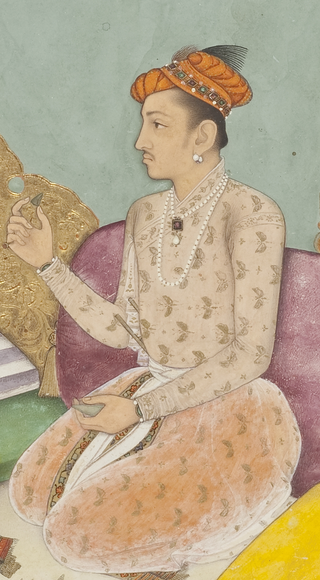
Jai Singh I was a senior general of the Mughal Empire and the Raja of the Kingdom of Amber. His predecessor was his grand uncle, Raja Bhau Singh.
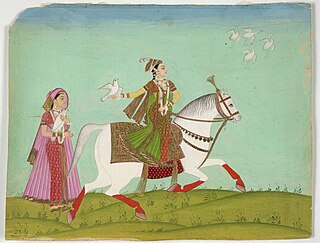
Sultana Chand Bibi was an Indian ruler and warrior. She acted as the Regent of Bijapur Sultanate during the minority of Ibrahim Adil Shah II in 1580-1590, and regent of Ahmednagar Sultanate during the minority of her great nephew Bahadur Shah in 1595-1600. Chand Bibi is best known for defending Ahmednagar against the Mughal forces of Emperor Akbar in 1595.
Odia Muslims are a community of people hailing from the Indian state of Odisha who follow Islam and primarily speak Odia language. They mostly descend from indigenous converts to Islam along with a small proportion that migrated from northern India. They are marked by their distinctive religious practices, food habits and language.

Narnala Fort or Narnala Qila Sarkar, also known as Shahnoor Fort, is a hill fortress in the Satpura Range of Vidarbh, Maharashtra, India, named after the Rajput Solanki Chalukya Ruler, Raja Narnal Singh, also known as Narnal Singh Swami. It was renamed as "Shahnoor" by Islamic rulers but again acquired, rebuilt and got its name "Narnala" by ruler Rao Rana Narnal Singh Solanki, who migrated from Patan in Gujarat.

Mian Noor Muhammad Kalhoro (1698-1755) ruled over Sindh as Subahdar of Mughal Emperor from 1719 till 1736 when he consolidated his power over entire Sindh, subjugating Bakhar Sarkar, Sehwan Sarkar, and Thatta Sarkar under his control and thus establishing a sovereign state, independent of Mughal suzerainty.

Zamindars of Natore were influential aristocratic Bengali Zamindars, who owned large estates in what is today Natore District in Bangladesh .

Manavati Bai, also spelled Manvati Bai,, better known by her title, Jagat Gosain, was the second wife and the empress consort of the fourth Mughal emperor Jahangir and the mother of his successor, Shah Jahan.

Mian or miyan is a royal title of the Indian subcontinent, also sometimes used as a surname. Begum or Beygum, is used to describe the wife of a Mian. It is used by several monarchs of Indian states.

Hussain Rabi Gandhi was an Indian Odia writer of the late-twentieth century, a politician and a cultural activist hailing from the Indian state of Odisha. Being a founder member of Biju Janata Dal, he served as the general secretary of the party from upon its formation in 1998 till 2005. In 1994 the title of Biplabi Loka Kabi was conferred upon him by the Mayor of Cuttack. He was also awarded with the title of Utkala Jyoti in 1996 by the then Deputy chief minister of Odisha, Basant Kumar Biswal on the behalf of Freedom Fighter's Organisation. Gandhi primarily wrote in Odia language and was bestowed with the Secular India Harmony Award in 1993 by the former President of India, Giani Zail Singh and with the Gangadhar Meher Kabita award in 2015 for his notable contributions to the field of Odia poetry. Hussain served as the President of Odisha Sahitya Akademi (2008–2010). He was famously known as the Gandhi of Korei and was regarded as a bridge between Western Odisha and Costal Odisha. He also served as Lead Member of Smt. Nandini Satpathy Memorial Trust (SNSMT).
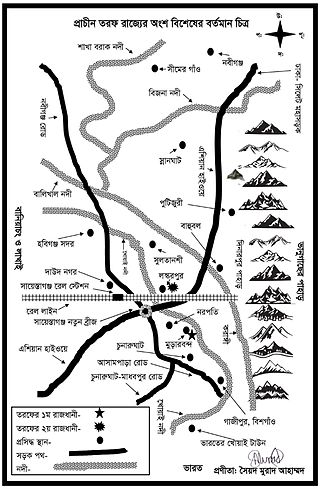
Taraf, previously known as Tungachal, was a feudal territory of the Sylhet region in Bengal and was under many petty kingdoms in different periods of time. It was part of what is present-day Habiganj District in Bangladesh.
Bayazid of Sylhet, also called Bayazid Karrani II, was a ruler in Sylhet during the early 17th century, in what is present-day Bangladesh. A prominent member of the Baro-Bhuiyan, Bayazid led military opposition against the Mughal Empire's expansion into eastern Bengal. His surrender following a sanguineous battle in 1612 ultimately resulted in their annexation of Sylhet.
Raja Syed Irfan Ali Choudhury was the 11th monarch of the quasi-princely state of Tarakote in Odisha. He's known for the wide social reforms that he had brought in the state. He was a staunch supporter of female education and had undertaken active steps to impart formal education to girls. He built the first girls school in Jajpur district in 1886.

The Bhoi dynasty or the Yaduvamsa dynasty were a medieval Hindu dynasty from the Indian subcontinent, which originated in the region of Odisha that reigned from 1541 to 1560 CE. Govinda Vidyadhara had usurped the throne from the later weaker Suryavamsa Gajapati Empire rulers as the kingdom started weakening but had a short-lived reign as ruling chiefs of Odisha as the ensuing internal rivalries and constant threats of invasions rendered them weak and were eventually overthrown by Mukunda Deva of Chalukya dynasty in 1560.

The Greater Noakhali region predominantly includes the districts of Noakhali, Feni and Lakshmipur in Bangladesh, though it has historically also included Bhola, Mirsarai, Sandwip and some southern parts of Tripura in India and southern Comilla. The history of the Noakhali region begins with the existence of civilisation in the villages of Shilua and Bhulua. Bhulua became a focal point during the Buddhist and Hindu kingdoms of Pundra, Harikela and Samatata leading it to become the initial name of the region as a whole. The medieval Kingdom of Bhulua enjoyed autonomy under the Twipra Kingdom and Bengal Sultanate before being conquered by the Mughal Empire. At the beginning of the 17th century, Portuguese pirates led by Sebastian Gonzales took control of the ara but were later defeated by Governor Shaista Khan. Affected by floodwaters, the capital of the region was swiftly moved to a new place known as Noakhali, from which the region presently takes its name. By 1756, the British East India Company had dominated and started to establish several factories in the region. The headquarters was once again moved in 1951, to Maijdee, as a result of Noakhali town vanishing due to fluvial erosion.
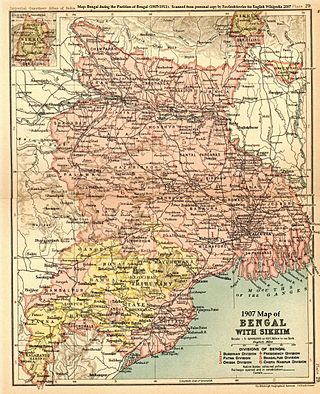
Kharui Raj principality traces its origin nearly three centuries, before the advent of British Raj in India. It was ruled by the descendants of Sayyid dynasty. The clan were practically independent rulers in the period between the collapse of Mughal Empire and the rise of the British Raj. The rulers were the descendants of Hasan ibn Ali, hence they assumed Hassan as their family name.

















